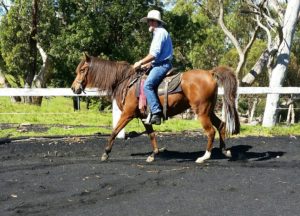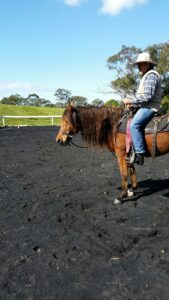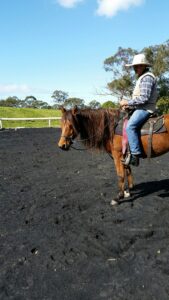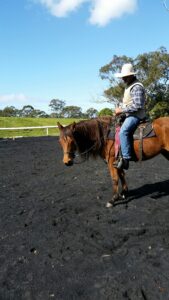In previous posts I’ve made references to softness – to soft ways of looking, to the softness in states of being calm, present and focussed, to the softness in a connection between human-and-horse. For example, with reference to the kangaroo experience, I said that Corey softly picked up a feel on the rein, and looked softly at the kangaroo to help Pia soften, relax and become curious. In this post, I want to think more about what is involved in a soft way of being and why this is so important to being-in-relation with horses.
Softness is a commonly used term in the horse world, but it is often understood in a superficial way, for example, as a desirable quality in an obedient horse, achieved with the use of some technique or other. Sometimes it is simply equated with lightness, the ‘lightness in hand’ when a horse easily comes off pressure. When softness is referred to as a human quality, it is also understood as something superficial and isolated – the need for soft hands for example.
For people working within the horsemanship traditions of Tom and Bill Dorrance and Mark Rashid, softness involves a wholeness and depth of being. Here, it is an open way of being that allows for softness between horse and human. Rather than being a matter of technique, softness is an essential quality of ‘feel’, that is, a connection between horse and human. It is a relational quality. From this perspective, any hardening of ourselves involves a closing and separation. (See eg Mark Rashid Finding the Missed Path, and Bill Dorrance True Horsemanship Through Feel.)
To get a sense of how softness feels, I’m going to start with a familiar experience of hardness in our work with horses – what happens when we are trying hard. Here is a scenario from my experience:
I’m getting on my horse, and I’m thinking: ‘I want to get a good turn’. I’m determined to get it right. I want Pia to walk off to the left and make a commitment to a turn in that direction. I try to use my focus and just softly take up the left rein. I am trying to be patient. She starts walking off to the left, but I can see that her mind is elsewhere – her feet are moving in one direction while her thoughts are out in the paddock with her friends. We’re going around in circles and nothing is changing. It seems to be taking ages. So I try to make it happen. I’m beginning to get frustrated. I’m sure I’m doing everything correctly but to no effect. I’m annoyed with myself, and, as impatience sets in, I’m now, ever so subtly, pulling a little on the left rein. I can feel tension in that arm, and Pia bracing against the pull. I’m holding my breath. I have become tense with the effort of trying to make something happen. Something apparently simple all seems too hard, and trying harder is clearly not working. I realize that we are out of communication, there is no connection. Time for a reset.
This sort of experience brings to mind the advice of a Zen master of archery to a student:
‘The right art’, cried the Master, ‘is purposeless, aimless! The more obstinately you try to learn how to shoot the arrow for the sake of hitting the goal, the less you will succeed in the one and the further the other will recede. What stands in your way is that you have too much wilful will. You think that what you do not do yourself does not happen.’ (Eugen Herrigel Zen in the Art of Archery)
The Master insists that a state of relaxation and letting go of oneself are crucial to ‘right work’ in any field: when we are ‘sunk without purpose’, immersed in whatever we are doing, the work ‘realizes itself as if of its own accord’. This is great advice for horsemanship.
In my trying hard scenario, I had become attached to a goal. It was there from the outset: ‘I want to get a good turn’. And this affected how things unfolded. It was all about my doing something, getting Pia to do something. I wasn’t listening to her at all. With too much wilful will, we do not listen – we are too focussed on ourselves, intent on making something happen, achieving our goal. Trying hard closes us off from the world, from our horse.
So, starting again, here is an alternative scenario. I remember to breathe and slow down to bring myself back to the present! When I have got onto Pia, I ask ‘are we in connection?’ That’s all. This question will have been present in everything we’ve done together prior to this moment, but I need to ask it again now, because without that connection nothing will work out. If Pia has become distracted, say, with thoughts about her friends in the paddock, I will just ever so quietly pick up a feel on a rein to say, ‘I’m here, come back to our connection’. Then, since I’m going to ask her to move to the left, I’ll ask her first to tune in with me in that direction. And I will wait, interested in what is happening. Then, when we are together, I will use my focus and energy to move in that direction. I might need to offer some help with a subtle directing rein, but I might not – wait and see. (See pictures of Corey waiting for a soft connection and Pia tuning in to the left.)
If this works, it all feels rather miraculous – there has been no effort, no sense of my doing anything. We are turning together in that direction, with ease and softness. If things don’t unfold as I’d hoped, I will be curious about how this has happened. I might ask, for example: Did we lose communication? Have I been clear in what I’m asking for? What is Pia telling me in her response? What was it about my state of being? Did I get ahead of myself? Was I distracted? How might I change?
Now, you can’t make yourself stop trying hard because that just leads to more trying hard. And trying hard to be soft doesn’t work either. Here’s a strategy that I use if I feel myself getting into a trying hard state about, for example, doing turns. I call it my ‘rocks and trees’ strategy for letting go of myself and goals. I head out of the arena into the bush where Pia and I have tasks to do together: we are going over rocks, between rocks, up and down slopes, around trees, weaving through the bush. We are engaged and interested in this adventure. I’ve forgotten the goal and myself, feeling completely focussed and absorbed in this activity. I’m having fun, feeling like a child, playing. Pia is interested, thinking down to her feet. More accurately, ‘we’ are ‘thinking’ or feeling down to her-our feet. And, we are doing turns! Turns that flow with ease, that seem to just happen. In this experience, I’m out of myself, in the bush with Pia, our horse-and-human feet and bodies weaving around trees. There are no hard edges or any sense of where one begins and the other ends. Rather, there is a feeling of openness and softness in our being together. I’m a different being from the one who was trying hard to get a turn.
Needless to say, my ‘rocks and trees’ activity can be done with anything, for example, with poles and witches’ hats in the arena. However, the bush works well for me because I can start to think about poles and witches’ hats as a try hard exercise! And if something becomes an exercise, horses will get bored, switch off and go into auto pilot. With ‘trees and rocks’, Pia and I are interested in what we are doing together.
Now look again at the picture above of Corey and Pia walking around the arena, or the pictures in the previous post of them turning around poles. Imagine your way into these experiences and the feel of softness in horse-and-human. And the ease with which things are happening. So, this raises the question: what are we doing if things happen without us making them happen? How do our horsemanship skills come into play if this is not a matter of will? How does working with ‘softness’, ‘feel’ and ‘focus’ differ from making a horse do something? Is this just a more subtle way of making a horse do something?
In this post I’ve been suggesting that softness involves a particular way of being, that, with softness, we are not ‘humans’ making ‘horses’ do something. In the next post, to address these questions of how things happen without us making them happen, I want to think about the spatial experience of a horse-and-human way of being. In other words, when things happen with ease, the key questions are: Who are we? and Where are we?
With thanks to Andrew and Corey